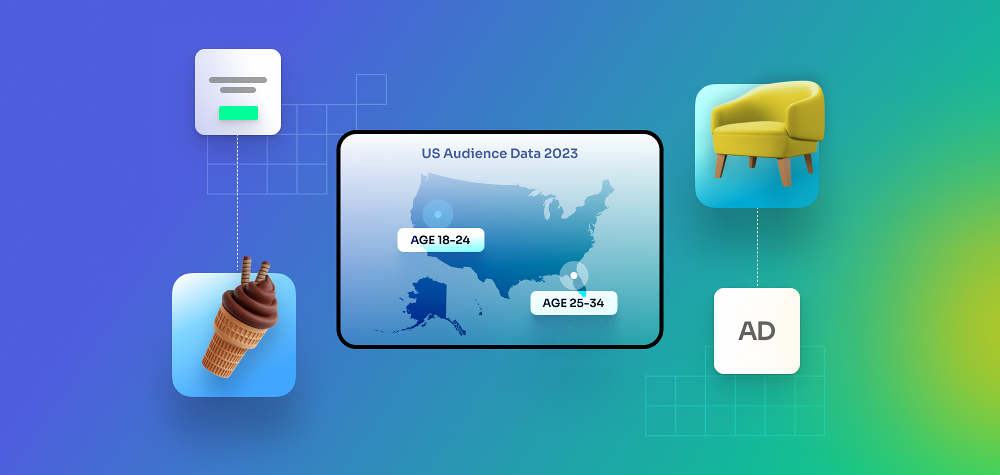“Data is the driver”.
Over the past decade, digital marketers have been turning more and more to the use of data to drive their campaigns and activities.
Perhaps the most important data of all is audience data. After all, understanding the audience is the number one rule of good marketing.
But how does audience data ‘work’? What different types are there, and how can each be collected and used? How can audience data help advertisers to capture the audience’s attention, increase conversions, and drive smarter digital campaigns? Let’s start at the beginning.
What is audience data and what can you learn about your audience?
Audience data is the term given for all the information that businesses can collect about potential and existing customers from their online presence and activity. This information is segmented into ‘audiences’, or groups of online users, based on a range of common parameters. Advertisers can use audience data to reach specific audiences who fit the buyer personas of the brand or business.
Given that there are close to 5.2 billion internet users worldwide (nearly 64% of the world’s population), audience data is a critical component of digital advertising. Instead of using the inefficient “spray and pray” method, audience data gives marketers the capability to identify the highest-potential online audiences and target their ad campaigns accordingly. This is key to driving better results from online campaigns, and improving ROI of digital advertising budgets.
What types of audience data are there?
Audience data covers a wide range of parameters and characteristics. Audience data that is richer and more complex can be used to create more granular segments. Here are some of the common types of audience data that can be collected and used for ad targeting:
- Demographics: This includes information such as region, age group, gender, household data, family status, income, and education level.
- User intent: Data about users’ intentions based on online activity and behavioral patterns, such as search behavior.
- Brands and shopping: This includes information about the preferred brands, product categories and buying behaviors of online users.
- Interests: Using past online browsing, shopping and content consumption patterns, this audience data is an extrapolation of what categories, topics and products users are interested in.
- Contextual data: By tracking the context and content of web pages and apps that users visit, it is possible to segment and target audiences based on contextual data.
- Likely-to-be: Audience data that shows similar attributes to existing audience segments are likely to be interested in the same things.
- Mobile signals: Audience data from mobile user signals is highly valuable as it provides a solid picture of behavior combined with location and movement. Mobile audience data includes geo-behavioral information, such as places visited, times visited and frequency of visits.
How is audience data collected?
Audience data is collected by tracking and recording the behavior and activities of online users. There are several ways to do this, depending on who ‘owns’ the data and who has access to it. Online data privacy laws in various countries are in place to regulate and control the tracking, collection and use of consumer data. Non-compliance is a costly risk – in 2023, Meta was fined over 1 billion euros by the Data Protection Commission in Ireland for breaching the EU’s GDPR data privacy regulations.
In light of these restrictions, and for other reasons, first-party data is the gold standard. Let’s take a look at what first-party data is and why it is so important.
First-party data collection
First-party audience data is owned by the organization or platform that tracks and collects it. The organization is the ‘first-party’ of data ownership. For example, the audience data tracked and collected by Google on its ad network is Google’s first-party data. Only Google has the right to use it, and that right is subject to the consent of Google users.
To collect first-party data, the organization adds a tracking pixel on its websites and other online assets (ie. online product or platform, landing pages, etc). The pixel collects data from user activity on those sites, and the data is recorded and aggregated on data management software, such as a CRM. Examples include Salesforce, HubSpot or Microsoft Dynamics 365.
For mobile activity and apps, tracking is done with MAIDs (mobile advertising IDs). Both Apple and Android operating systems have their own tracking mechanisms and protocols. Like web-based tracking, app tracking is also becoming more restricted, making it more challenging for companies to track and collect audience data on mobile.
First-party data is extremely valuable because it provides the organization with direct access to their customer data, without having to use an intermediary. This not only saves costs; it also offers unique and proprietary customer information that can be used for a wide range of business activities.
Even so, there are some limitations. What is the disadvantage of first-party data? For starters, the user must actively provide consent or opt-in to be tracked with first-party cookies. Also, there are many restrictions on how the customer data can be used once it is collected, including cross-border restrictions. Companies must stay on their toes to ensure they are complying with data privacy laws in all the regions where online customers are located.
First-party vs Third-party data collection
While first-party data is owned by the organization that tracks it, third-party data is not. Third-party data is audience data that is collected by a separate entity or organization. In order to access third-party data, the advertiser or business must purchase it from the owner.
Third-party data sets are sometimes created from an aggregation of data from multiple sources, packaged and supplied by the data provider. Companies buy this data in order to understand their potential audiences and learn how better to target them.
One of the main problems with third-party data is cookie depreciation and increased regulations on MAIDs for mobile tracking. When cookies are phased out, companies will no longer have access to the wide data pools of third-party data that are currently available. This makes it even more important to boost access to 1st party data.
In addition, third-party data is possibly less reliable than a first-party data strategy. Having passed through several ‘hands’, it will not be as accurate as the data collected directly from customers. Also important to note is that third-party data is available to anyone willing to pay for it, meaning that competitors have equal access. This is not the case with proprietary first-party data.
Limitations on data collection
One of the most pressing and ongoing challenges for audience data collection is the issue of data privacy. Digital data privacy laws are complex and they vary from country to country. In the US, many states have their own rules and regulations.
Businesses are not only bound by the data privacy laws in the jurisdiction where they are located. They must comply with regulations in all areas where their online users are located too. For example, a company based in California with customers in the EU must be in compliance with Californian and European regulations.
While dozens of countries and states have their own specific laws and regulations, here are the ones that are mentioned the most:
GDPR: The General Data Protection Regulation was brought into effect in 2018 and covers the European Union. It is considered one of the strictest privacy regulations in the world and was the first to have a global impact on digital advertising and online businesses. The GDPR was designed to provide the consumer public with more rights and control over the processing and use of their online personal data. Individual countries may have implemented local versions of the GDPR to suit their legislative processes; for example, in the UK, the GDPR is known as the Data Protection Act 2018.
CCPA: California was the first US state to implement data privacy laws, with the California Consumer Privacy Act (CCPA) of 2018. The regulation gave consumers the right to opt-out of online tracking and sharing of their personal data, and to delete personal data collected from them online.
Apple ATT: With the release of iOS 14, Apple also launched its new data privacy framework, AppTracking Transparency (ATT). With ATT, Apple required app developers to ask permission from users to track their activity, making it easier for members of the public to safeguard their personal information while using iPhones, iPads and Apple TV.
Google Privacy Sandbox: Google is still working on its Privacy Sandbox initiative, set to launch for general availability in mid 2023. The initiative aims to phase out third-party cookies on the web, so that users are tracked anonymously rather than based on unique identifiers. The Privacy Sandbox for Android will eliminate cross-app identifiers and limit the ability to track user activity on mobile via third-party tracking sources.
Value of your audience data
Audience targeting is a two-way street. Advertisers aim to engage and convert relevant audiences. At the same time, consumers want an enjoyable and compelling online experience. They don’t like seeing ads for products or brands that are not relevant or interesting to them.
The key is relevance, and that is where the true value of audience data lies.
By analyzing audience data and segmenting it into groups with common characteristics, advertisers can finetune their targeting strategy and serve relevant ads to audiences that are more likely to be interested and convert.
For example, audience data can be segmented according to consumer interest categories. As one of the leading first-party data providers, Start.io’s Audiences Hub offers audience data segments for mobile users across hundreds of niches and locations. Advertisers can choose a segment that is relevant to their brand and product (ie. car owners in Massachusetts), and tailor in-app ads that will be compelling and interesting for that audience.
When audience data segmentation is leveraged at scale, advertisers can reach large numbers of potential customers in a far more effective and targeted way.
Here are some examples of audience segmentation that can be used to optimize ad relevance and campaign performance:
- Pre-pack audiences: Pre-pack audiences are a form of curated supply. They are created by the data provider or SSP in advance so they are ready to activate for ad campaigns. These segments are based on audience data analysis that groups together audiences based on predefined characteristics. For example, a sports brand marketing to young women can choose audience segments such as “female sports” fans or “females interested in tennis” or other pre-pack segments depending on their target audience.
- Custom audiences: Custom audiences are segments curated specifically for a particular advertiser or campaign, depending on their goals and buyer personas. These segments are built by businesses themselves or their data providers, based on analysis of first-party audience data. Custom audiences are a helpful tool for businesses targeting niche audiences that are not available in curated pre-packs.
- Retargeting: Retargeting is a powerful tactic to target audiences who have already visited a website or engaged with a brand online. Retargeting ads help to remind the audience that they had shown interest before, and encourage them to re-engage. For example, a retargeting campaign can use audience data to serve ads to a specific group of users who visited a particular product page in an e-commerce store. The ads can present a discount offer to tempt them to visit again and buy.
- Data-driven audiences: According to Oracle research, data-driven audiences are far more effective than simple demographic targeting to reach potential buyers. Compared with regular non-targeted ads, the value of data-driven audiences is even more evident. This finding is consistent across brands, categories and audiences. The bottom line? Using audience data for online targeting is essential to boosting performance and advertising ROI.
Activate your audience
When an audience segment has been chosen, the next step is to activate it. Many data providers offer the ability to activate audiences automatically, or to integrate with a range of SSPs for first-party data activation across several platforms.
Start.io’s mobile audience platform, for instance, offers a “plug-in” audience activation feature. Advertisers can choose from a range of pre-pack audiences, such as consumer insights-based segments, Likely-to-be audiences, and more, or create custom audiences that are ready to activate with a few simple clicks.
Advertisers can combine the benefits of audience data with easy, fast activation, ensuring audience targeting at scale with the highest potential to drive results, and the least investment of time and resources.
Take a look at Start.io’s taxonomy and discover a comprehensive range of mobile audience segments, ready to activate across the world’s leading programmatic platforms.
Audience Data FAQ
How to collect first-party data?
Collecting first-party data online involves obtaining information directly from your website visitors or customers. This can be done by installing a pixel on your website and other digital assets that tracks the activity of users during their time spent on the site. There are many other methods of 1st-party data collection, including website forms, loyalty programs, surveys, account registrations, purchase history, and chatbot responses.
Why is reaching your target audience important in data analysis?
Reaching your target audience has a direct impact on the accuracy and relevance of the insights gained from data analysis. By focusing on the right audience, you can gather data that aligns with your business goals and customer preferences. This also ensures that the data collected is meaningful and actionable, and it can be used effectively to drive better performance and outcomes for your business.



